Last summer contained plenty of change for Ajax.
After finishing third in the Eredivisie, 13 points off champions Feyenoord, the entire Board of Directors resigned, along with interim manager John Heitinga not being retained after Alfred Schreuder was sacked only a few months into the 2022/23 season.
Then, Ajax appointed Maurice Steijn as their new manager this summer, taking him from Sparta Rotterdam.
After that, the transfer window went into full flow, with plenty of incomings and outgoings occurring at the Amsterdam club.
It all began with club captain Dušan Tadić terminating his contract over what he called a “lack of quality in the squad”.
Key players were sold, with Mohammed Kudus and Edson Álvarez joining West Ham United, Jurriën Timber joining Arsenal, Calvin Bassey joining Fulham, and Mohamed Daramy joining Stade de Reims.
However, Ajax have made some excellent signings as well, with the club essentially rebuilding Steijn’s attack.
In regards to attacking signings, Carlos Borges has come in from Manchester City, Chuba Akpom from Middlesbrough, Benjamin Tahirović from Roma, Branco van den Boomen from Toulouse, and now are very close to completing the signing of 22-year-old Georgian forward Georges Mikautadze from FC Metz.
This Maurice Steijn tactical analysis will look at two names who will be interesting to see in this new-look Ajax attack: Benjamin Tahirović and Carlos Borges.
Both players have had relatively short careers at the senior level, and they will likely be asked to make a significant impact by Maurice Steijn throughout this season.
How will Benjamin Tahirović fit into Maurice Steijn Ajax attack?
The first new key attacking player that this analysis will look at is Bosnian midfielder Benjamin Tahirović.
The 20-year-old joined from AS Roma for a fee in the region of €7.5 million, with his signing representing an excellent investment for the Amsterdam side.
The young Bosnian international brings multiple traits to the Ajax midfield, probably none more key than his range of passing and distribution.
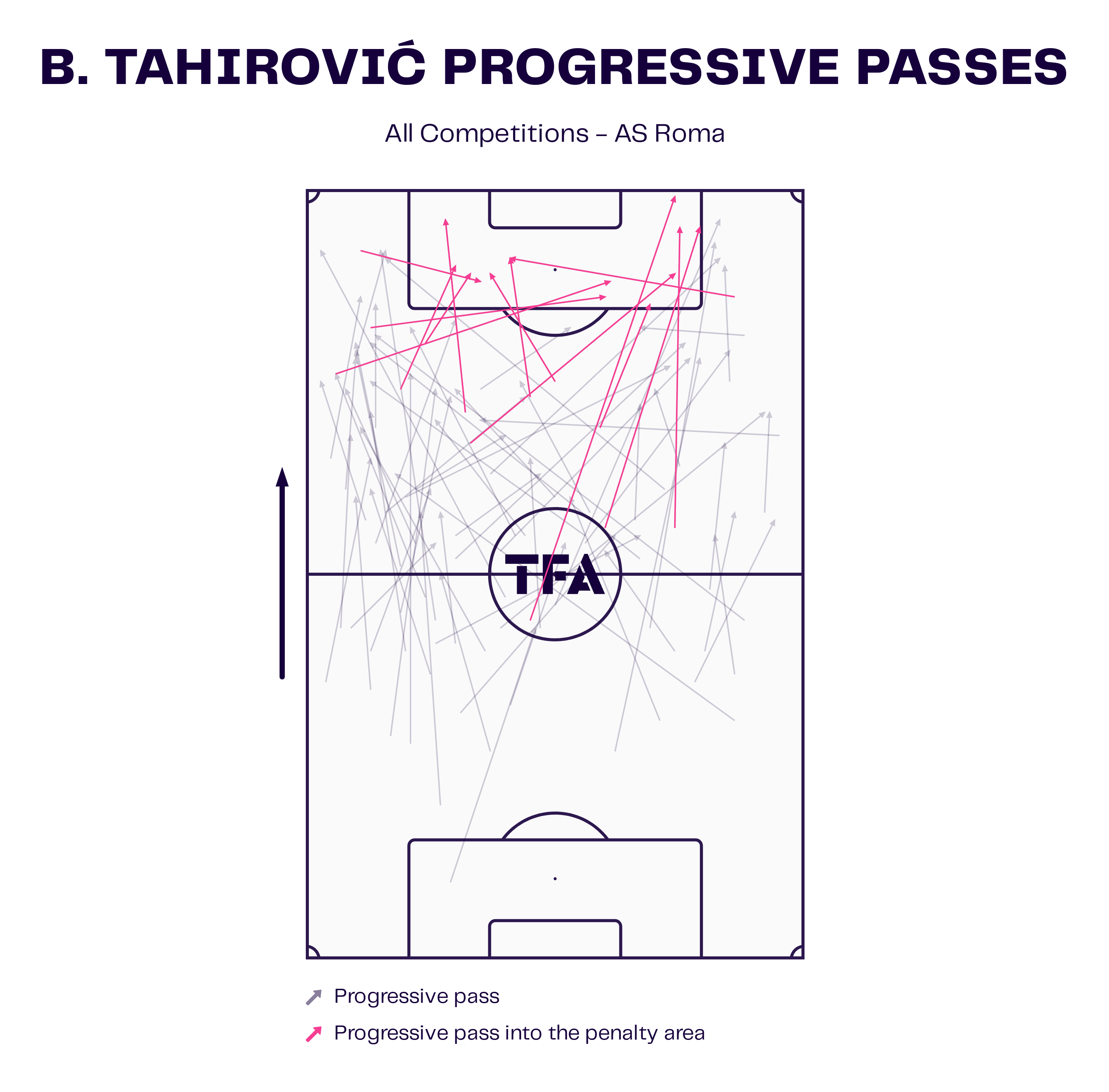
The data viz graphic above shows the progressive passes of Benjamin Tahirović during his time with AS Roma last season and currently with Ajax.
The 20-year-old Bosnian international has started in all three of Ajax’s matches this season, with him forming a partnership alongside fellow new signing Branco van den Boomen as part of a double pivot.
In this partnership, the 20-year-old has been given more freedom in the future by Maurice Steijn, and this has been instrumental to his success so far, with Tahirović already contributing an assist this season.
Looking more closely at the graphic, we can see that most of the Bosnian’s progressive passes have been coming from deeper areas in midfield.
Still, this season with Ajax, the 20-year-old has already played three progressive passes into the penalty area, with it looking likely he will be able to contribute more going forward under Maurice Steijn this season, with these following examples looking at what Tahirović can offer the Dutch giants and what he may bring to their attack in the long term.
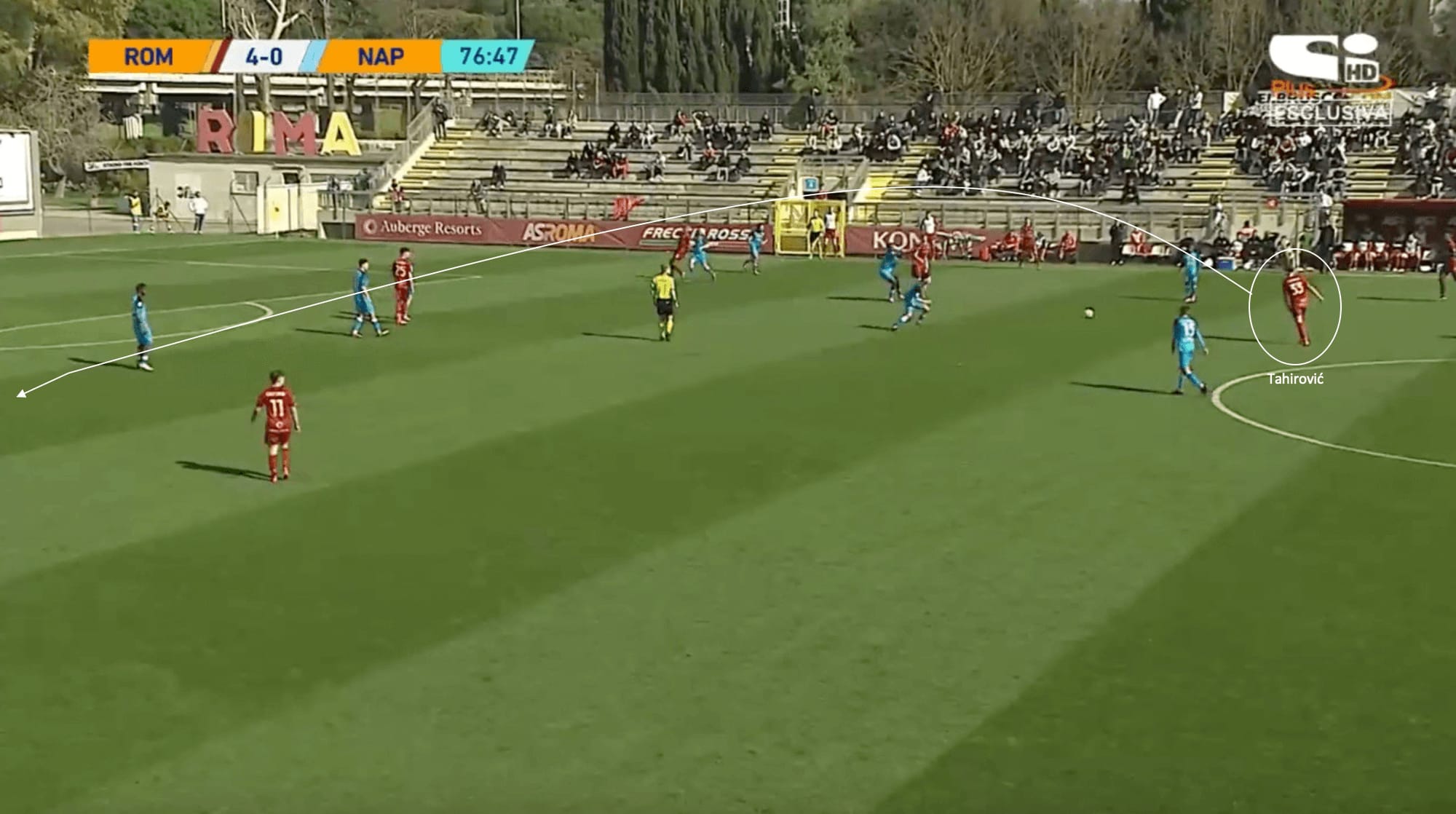
The image above shows an example of Benjamin Tahirović’s range of distribution and ability to spray progressive passes from deeper-lying midfield areas.
In this phase of play above from a Roma Primavera game against Napoli Primavera, the Bosnian is operating in a deeper midfield position.
The 20-year-old receives the ball and plays a first-time cross-field ball behind the opposition’s backline into the path of the wide player.
The midfielder is able to find a pocket of space in this deeper-lying area and uses it wisely to progress the ball into the final third for Roma, pinning back the Napoli defence as a result.
This first-time ball finds the wide player in space on the opposite touchline and shows that the Bosnian will play these cross-field balls often to try and quickly switch the point of attack, bypassing players and getting it directly to the end source.
This may be something that Maurice Steijn will often utilise from the 20-year-old, and already has with the amount of time he has already spent in the attacking third of the pitch for Ajax.
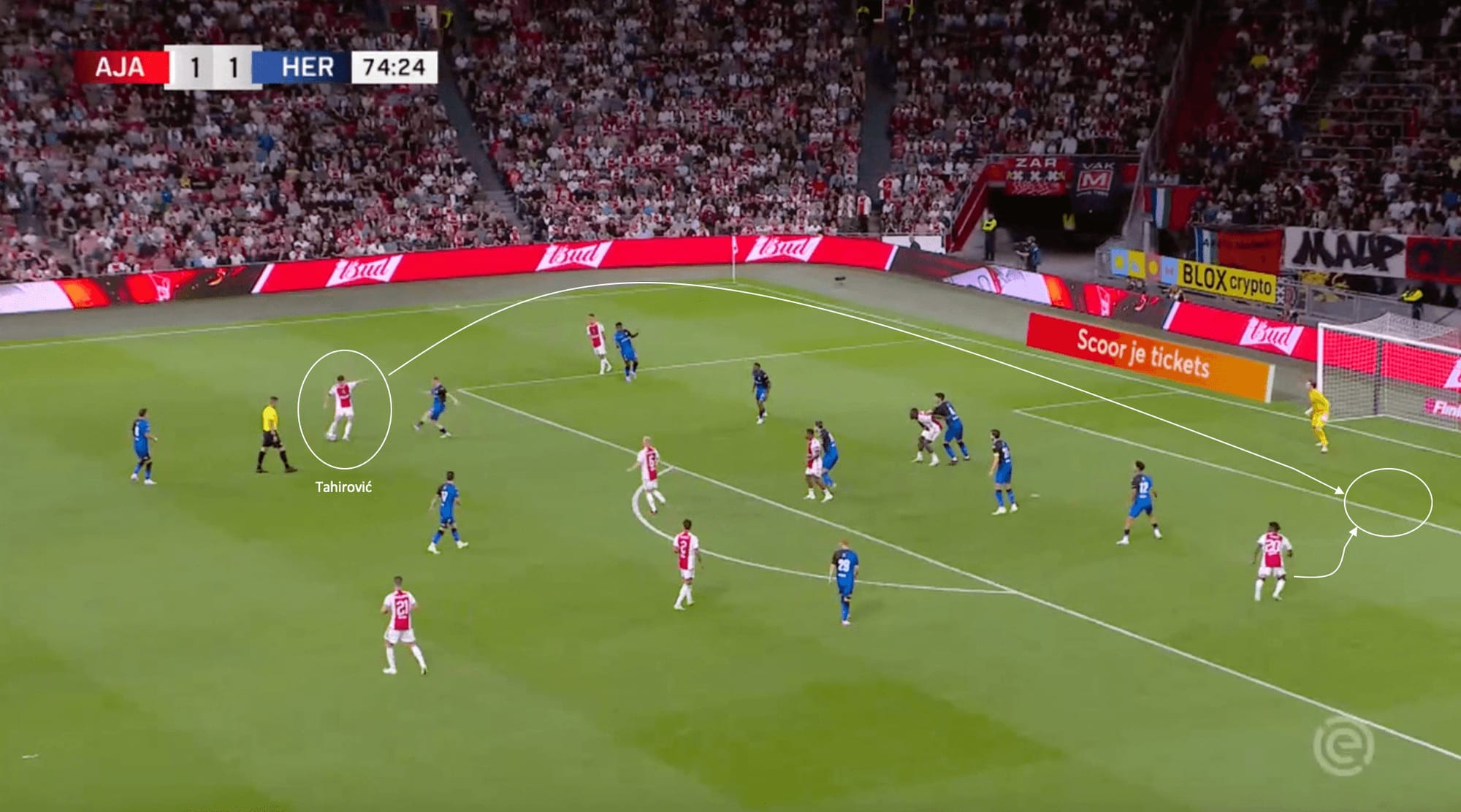
The image above shows a similar position for Benjamin Tahirović, this time for Ajax and also in a more forward position than the previous example.
In this phase of play from the Dutch side’s first match of the new season against Heracles, the Bosnian international finds himself in the half-space, just outside of the opposition’s penalty area.
In what is similar to the first example, the 20-year-old midfielder plays a crossfield ball into the space just behind the Heracles defensive line, where Mohammed Kudus was waiting.
This crossfield ball leads to the Bosnian’s first assist in Amsterdam, with the Ghanaian able to slot home past the goalkeeper.
Again, this illustrates how Ajax’s attacks can now become quicker-paced and clinical with the abilities of the young midfielder.
Learning under José Mourinho at Roma taught Tahirović about quick counter-attacking football, looking to dominate sides by playing quickly and progressing the ball into the penalty area in as few passes as possible.
With Tahirović in this Ajax squad, Steijn may be able to play more fast-paced attacking football, with the Bosnian international’s distribution and range of passing allowing Ajax to change the point of attack quicker, bypassing lateral options and playing less square passes, which eliminates the ability for opposition defences the time to shift side-to-side to prevent penetrating ball played behind them and into the penalty area.
How will Carlos Borges fit into this Ajax attack?
Another exciting young player Ajax acquired this summer transfer window was 19-year-old Manchester City academy product and Portugal U19 international winger Carlos Borges, who joined the Dutch side for a fee in the region of €14 million.
The young, tricky winger brings an outstanding dribbling ability to Amsterdam, with him likely the long-term replacement on the right side of attack to the now departed Mohammed Kudus.
In Ajax’s last league game against Excelsior, the Portugal youth international started on the right side of midfield in a 4-2-3-1, with Kudus moving into a central position.
As previously mentioned, dribbling is the 19-year-old’s speciality, with him averaging 6.21 dribbles per 90 minutes and a success rate of 56.1% in his career so far.
Compare that to Kudus, who has averaged 6.47 dribbles per 90 minutes in his senior football career, with a success rate of 56.9%, and you can see why Sven Mislintat and Ajax were intrigued by the prospect of the Portuguese replacing the Ghanaian.
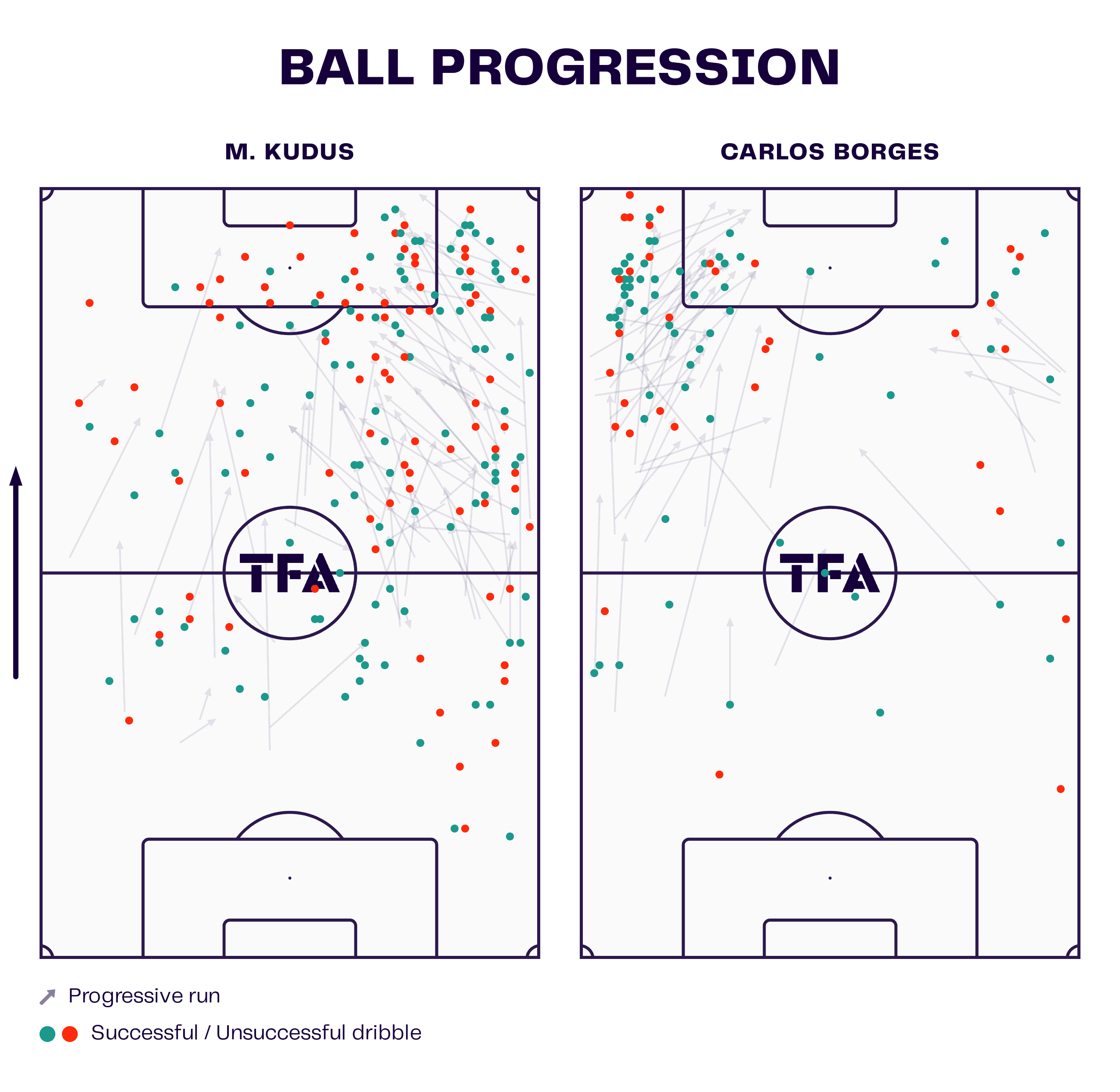
The data viz graphic above compares both Carlos Borges and Mohammed Kudus’s ball progression both this campaign so far and last, looking specifically at progressive runs and dribbles.
As the graphic illustrates, Kudus has attempted a lot more than Borges in the season and a bit, but both have been highly successful when it comes to around the penalty box and in the final third of the pitch.
Another thing to point out is the position that Borges played often on the left flank for Manchester City’s youth sides last season.
However, the Portugal U19 international is left-footed, so being played on the right side by Steijn allows him to be an inverted winger, allowing him the ability to dribble past players before cutting inside on his favoured left foot.
So far in his young Ajax career, the 19-year-old has been deployed as both a right-sided midfielder in a 4-2-3-1 and as a right winger in a 4-3-3, which shows that this is likely where Maurice Steijnn sees him in his plans.
The biggest question will be whether he can replace Mohammed Kudus’s output during his time in Amsterdam.
With the 23-year-old scoring a hat trick on his final ever appearance for the Dutch club, and with a total of 27 goals and 12 assists in his career for Ajax, Borges has some work to do, but as these following examples show of his on the ball ability, he will be someone that Maurice Steijn will likely heavily rely on for the future.
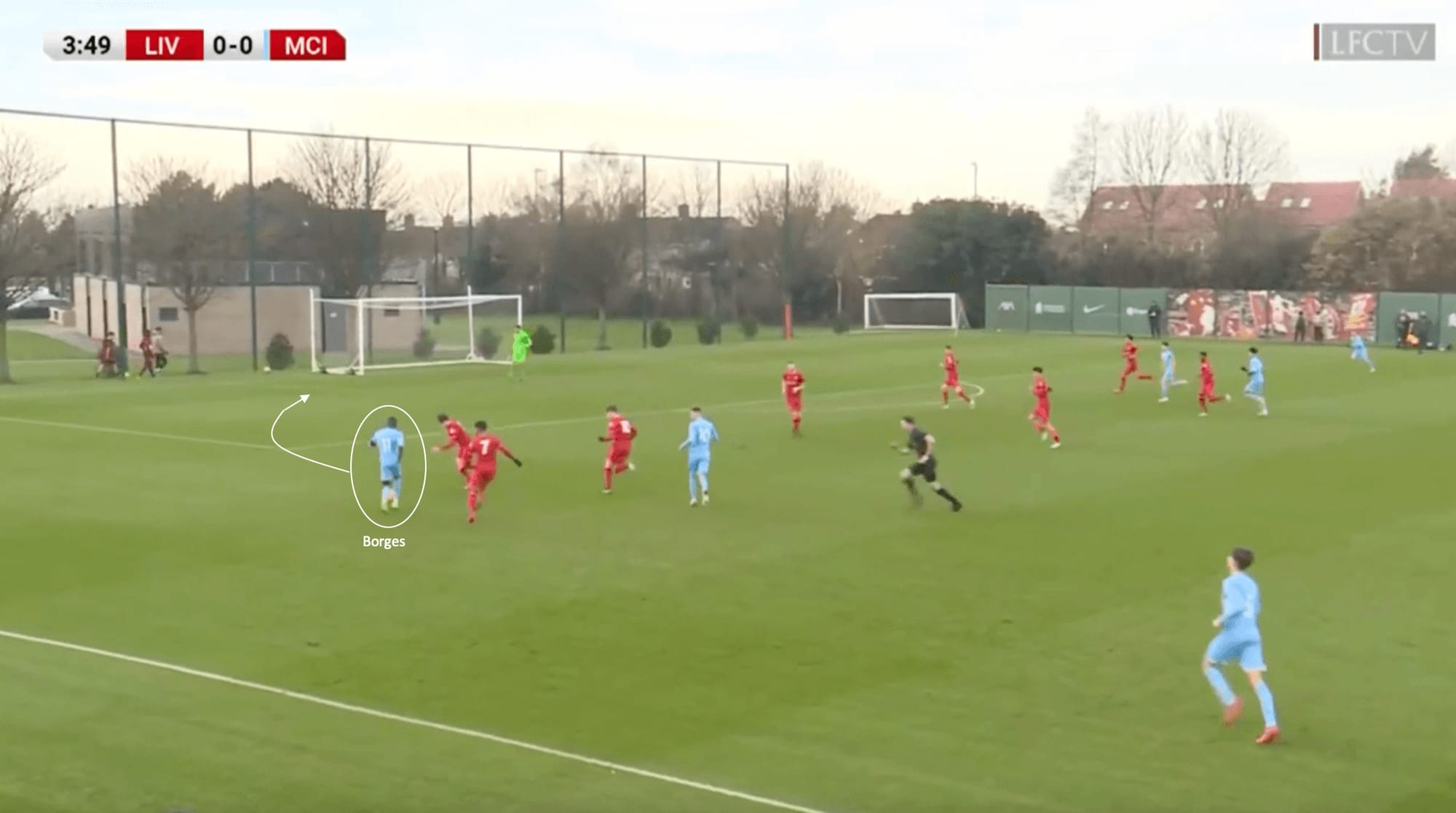
The image above shows an example of the dribbling ability that Carlos Borges is capable of and the moments that he can produce from almost nothing at times.
In this phase of play above from a match against the Liverpool youth team, the Portuguese U19 international is in possession and dribbling at the Liverpool fullback, who is currently backpedalling towards his own goal.
The 19-year-old’s quick feet and movement allow him to get the opposition defender off balance, with Borges showing the defender to the inside to get him off balance before bursting to the outside to go around him.
The defender does stay with him, but he can out-muscle him, also demonstrating the strength that he possesses.
Regarding how Mohammed Kudus likes to play, it is relatively similar, with both players demonstrating a good balance of athleticism and strength when they are in possession out in the wide areas.
Borges is definitely a raw talent.
However, with him not getting too many look-ins at the senior level in recent years, it will be an adjustment period for him to get up to the demands of senior football.
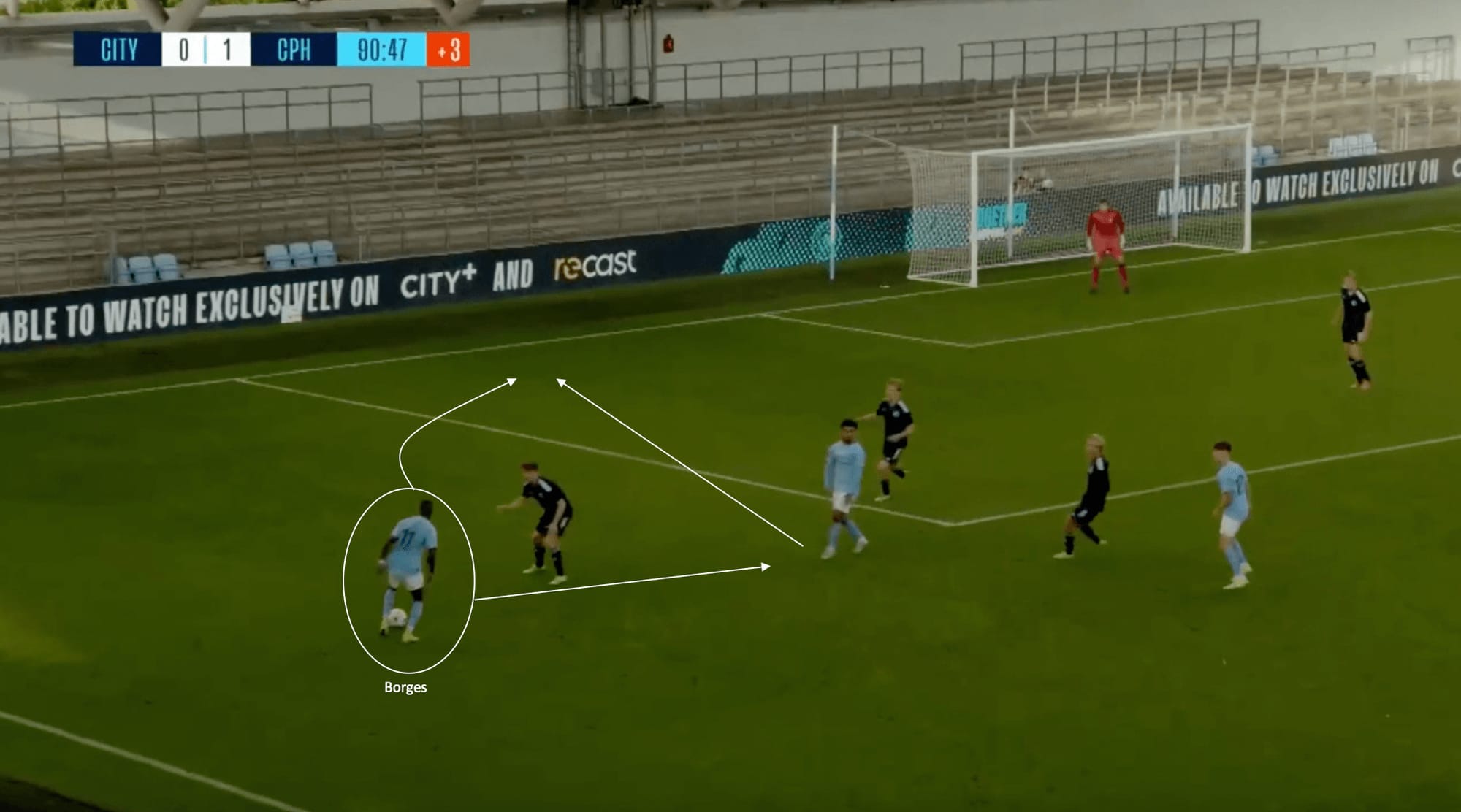
The image above shows another example of the dribbling ability, strength, and physicality that Carlos Borges possesses.
In this UEFA Youth League match against FC Copenhagen, the young Portuguese winger was in possession on the near touchline.
The winger is isolated against the opposition fullback, with him able to keep the defender guessing what he will do due to his quick feet.
Borges plays a one-two with his teammate nearby, who has drifted over to support, with him passing the ball off and using a burst of acceleration to get past the fullback.
He also is able to use his strength to muscle the defender off him as he regains possession and tip-toes along the end line before delivering a great ball across the box for his teammate on the other side of the penalty box to tap home.
As this section has shown, in many ways, Carlos Borges is rather similar to the type of player that Mohammed Kudus has been for Ajax for the past few seasons.
It remains to be seen whether he can have the same success as the Ghanaian did, but his trickery and pace offer Maurice Steijn many positive things from an attacking perspective.
It would not be surprising to see the Dutchman try to utilise Borges in a similar role that Kudus was used in during the first three matches of the new campaign, with Borges also offering the ability to play as an inverted winger on the right side, with the Portuguese able to cut inside on his left foot from the right and take on shots from distance.
Conclusion
As this tactical analysis has shown, Maurice Steijn has plenty of different attacking options currently at his disposal.
With the imminent arrival of Georges Mikautadze and the awaited debut of Chuba Akpom, much more could still happen, and this attack can develop further.
However, in Benjamin Tahirović and Carlos Borges, the Dutch manager has two young players who are beginning to thrive in his tactics, and it will be interesting and exciting to see how the season develops for the Dutch giants as they look to regain their Eredivisie crown.





Comments